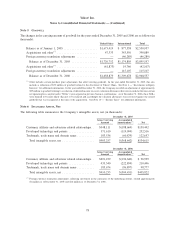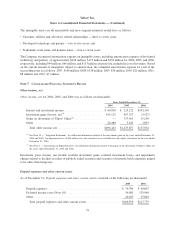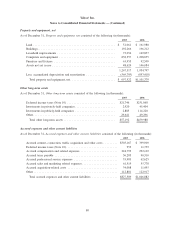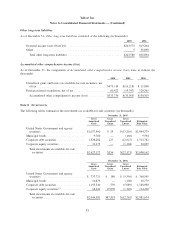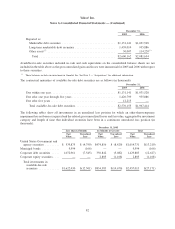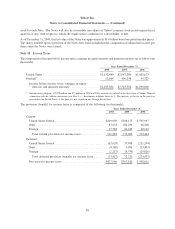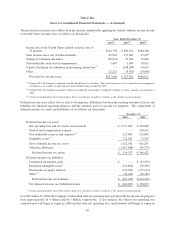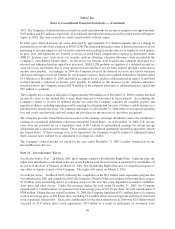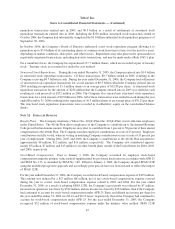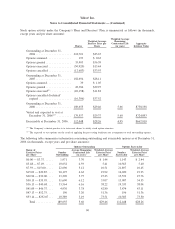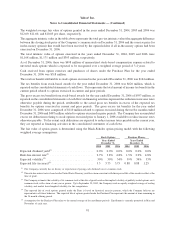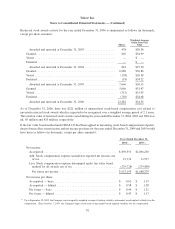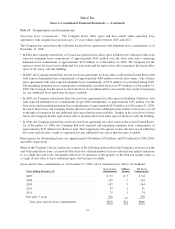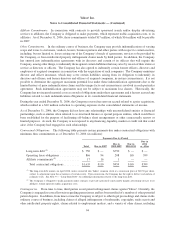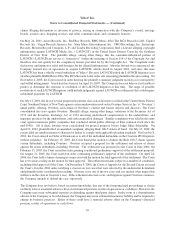Yahoo 2006 Annual Report Download - page 96
Download and view the complete annual report
Please find page 96 of the 2006 Yahoo annual report below. You can navigate through the pages in the report by either clicking on the pages listed below, or by using the keyword search tool below to find specific information within the annual report.2013. The Company’s federal and state research tax credit carryforwards for income tax purposes are approximately
$107 million and $97 million, respectively. If not utilized, the federal research tax credit carryforwards will begin to
expire in 2010. The state research tax credit carryforwards will not expire.
In 2006, gross deferred income tax assets decreased by approximately $1.0 billion primarily due to a change in
presentation as a result of the adoption of SFAS 123R. The reduction primarily relates to deferred income tax assets
pertaining to net operating loss and tax credit carryforwards resulting from the exercise of employee stock options
in prior years and represents tax benefits in excess of stock-based compensation expense as determined under
APB 25. In prior years, such excess tax benefits, with an offsetting valuation allowance, were recorded in the
Company’s consolidated balance sheet. As the excess tax benefits were realized, the valuation allowance was
released and additional paid-in capital was increased. SFAS 123R prohibits recognition of a deferred income tax
asset for excess tax benefits due to stock option exercises that have not yet been realized through a reduction in
income taxes payable. Accordingly, in 2006 the Company reversed the deferred tax asset and related valuation
allowance relating to excess tax benefits for stock option exercises. Such unrecognized deferred tax benefits totaled
$1.1 billion as of December 31, 2006 and will be accounted for as a credit to additional paid-in capital, if and when
realized through a reduction in income taxes payable. In addition to the decrease in the valuation allowance
described above, the Company released $236 million of the valuation allowance to additional paid-in capital and
$95 million to goodwill.
The Company has a valuation allowance of approximately $96 million as of December 31, 2006 to reduce deferred
income tax assets to the amount that is more likely than not to be realized in future periods. In evaluating the
Company’s ability to recover its deferred income tax assets the Company considers all available positive and
negative evidence, including operating results, ongoing tax planning and forecasts of future taxable income on a
jurisdiction by jurisdiction basis. The valuation allowance as of December 31, 2006 relates to foreign net operating
loss and credit carryforwards and will reduce the provision for income taxes if and when recognized.
The Company provides United States income taxes on the earnings of foreign subsidiaries unless the subsidiaries’
earnings are considered indefinitely reinvested outside the United States. As of December 31, 2006, U.S. income
taxes were not provided for on a cumulative total of $0.7 billion of undistributed earnings for certain foreign
subsidiaries and a corporate joint venture. These earnings are considered indefinitely invested in operations outside
the United States. If these earnings were to be repatriated, the Company would be subject to additional United
States income taxes (subject to an adjustment for foreign tax credits).
The Company’s federal income tax return for the year ended December 31, 2003 is under examination by the
Internal Revenue Service.
Note 11 STOCKHOLDERS’EQUITY
Stockholder Rights Plan. In March 2001, the Company adopted a Stockholder Rights Plan. Under the plan, the
rights were distributed as a dividend at the rate of one Right for each share of common stock held by stockholders of
record as of the close of business on March 20, 2001. The Stockholder Rights Plan was not adopted in response to
any effort to acquire control of the Company. The rights will expire on March 1, 2011.
Stock Repurchases. In March 2005, following the completion of the $0.5 billion stock repurchase program that
was authorized in 2001 and extended in 2003, the Company’s Board of Directors authorized the repurchase of up to
$3.0 billion of its outstanding shares of common stock over the next five years, dependent on market conditions,
share price and other factors. Under this program, during the year ended December 31, 2005, the Company
repurchased 11.7 million shares of common stock at an average price of $33.20 per share, for total consideration of
$388 million. During the year ended December 31, 2006, the Company repurchased 93.1 million shares of common
stock at an average price of $29.84 per share, including 31.6 million shares received upon the maturity of structured
stock repurchase transactions. Total cash consideration for the stock repurchases in 2006 was $2.8 billion which
consisted of $1.8 billion direct stock repurchases, $0.5 billion as a result of settlements of structured stock
86
Yahoo! Inc.
Notes to Consolidated Financial Statements — (Continued)




